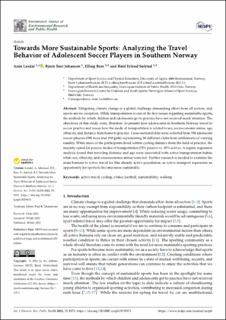| dc.contributor.author | Laxdal, Aron Gauti | |
| dc.contributor.author | Johansen, Bjørn Tore | |
| dc.contributor.author | Bere, Elling Tufte | |
| dc.contributor.author | Solstad, Bård Erlend | |
| dc.date.accessioned | 2023-03-02T13:36:41Z | |
| dc.date.available | 2023-03-02T13:36:41Z | |
| dc.date.created | 2022-08-06T15:03:57Z | |
| dc.date.issued | 2022 | |
| dc.identifier.citation | International Journal of Environmental Research and Public Health. 2022, 19(15), Artikkel 9373. | en_US |
| dc.identifier.issn | 1661-7827 | |
| dc.identifier.uri | https://hdl.handle.net/11250/3055425 | |
| dc.description | This article is an open access article distributed under the terms and conditions of the Creative Commons Attribution (CC BY) license (https://creativecommons.org/licenses/by/4.0/). | en_US |
| dc.description.abstract | Mitigating climate change is a global challenge demanding effort from all sectors, and sports are no exception. While transportation is one of the key issues regarding sustainable sports, the methods by which children and adolescents get to practice have not received much attention. The objectives of this study were, therefore, to present how adolescents in Southern Norway travel to soccer practice and assess how the mode of transportation is related to sex, socioeconomic status, age, ethnicity, and distance from home to practice. Cross-sectional data were collected from 558 adolescent soccer players (398 boys and 190 girls) representing 30 different clubs from settlements of varying rurality. While most of the participants lived within cycling distance from the field of practice, the majority opted for passive modes of transportation (55% passive vs. 45% active). A logistic regression analysis found that traveling distance and age were associated with active transportation habits, while sex, ethnicity, and socioeconomic status were not. Further research is needed to examine the main barriers to active travel for this already active population, as active transport represents an opportunity for sports to become more sustainable. | en_US |
| dc.language.iso | eng | en_US |
| dc.subject | active travel | en_US |
| dc.subject | cycling | en_US |
| dc.subject | e-bike | en_US |
| dc.subject | football | en_US |
| dc.subject | sustainability | en_US |
| dc.subject | walking | en_US |
| dc.title | Towards more sustainable sports: Analyzing the travel behavior of adolescent soccer players in Southern Norway | en_US |
| dc.type | Peer reviewed | en_US |
| dc.type | Journal article | en_US |
| dc.description.version | publishedVersion | en_US |
| dc.rights.holder | © 2022 by the authors | en_US |
| dc.source.pagenumber | 7 | en_US |
| dc.source.volume | 19 | en_US |
| dc.source.journal | International Journal of Environmental Research and Public Health | en_US |
| dc.source.issue | 15 | en_US |
| dc.identifier.doi | 10.3390/ijerph19159373 | |
| dc.identifier.cristin | 2041451 | |
| dc.description.localcode | Institutt for idrett og samfunnsvitenskap / Department of Sport and Social Sciences | en_US |
| dc.source.articlenumber | 9373 | en_US |
| cristin.ispublished | true | |
| cristin.fulltext | original | |
| cristin.qualitycode | 1 | |
